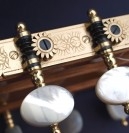Tips for Practising Scales
Scales should be a regular part of your practice routine. Use them as warm up exercises before working on your pieces. They make up 14% of the marks available in an exam, so it is worth spending five minutes playing them at the start of a half hour practice session.
The examiner is looking for accuracy in notes and rhythm, tone, projection and a smooth, legato sound. He can not comment on your technique or style, but you will need good technique to achieve the above features in your playing so take care with your posture and how you are using your hands. Scales are an ideal time to assess these areas of your playing since you are not focusing on reading.
The first step is to memorise your scales, follow these steps:
- Memorise one scale at a time. You can only memorise a small amount of information in one go. This must then be gone over several times before you can be sure it is safe to work on another scale. Frequent revision is needed to keep scales in your head.
- Play slowly. Get the fingering right first time. I mean really slowly. Play each note four times to give you a chance to prepare for the next note.
- Make sure you understand any position changes before starting to memorise a scale. There are many, many ways of playing a scale. The suggestions in the current AB syllabus are fantastic and will help you improve your playing. However, they are not the most obvious fingerings in most cases and you may be tempted to go for familiar first position scale shapes. Staying low will not help you progress and usually presents a more technically demanding pattern which no one would choose to use when performing.
- Project and play smoothly. Once a scale has been memorised, you get the chance to watch and listen in a way that is not possible when sight reading. Join your notes up so there is no silence between notes. Push your guitar to its limits. Take care not to strike too hard or it sounds nasty, but be bold! Watch out for buzzing notes too.
- Speed up. This is of the least importance but scale practice is the perfect time to work on your dexterity. Remember that speed comes from accuracy, you should not loose quality for the sake of faster scales.
Playing your scales
Use the attachment at the bottom of this page to learn a simple way to memorise a scale. I have used G major from grade one as my example. Please take time to play the exercises even if you are on a higher grade. This memorisation technique may be applied to any scale.
Exercises 1 - 5 help your fingers find the notes. Repeat each exercise as many times as necessary to feel comfortable. You should not be trying to memorise anything at this stage, you are simply making sure you can comfortably play the scale.
Once you can play the scale comfortably with the music, look at exercises 6 - 10. This starts with the first four notes of G major. Play exercise 6 with the music, then look away and play it from memory. If you are happy with this you may move on to exercise 7, if not, you should repeat the exercise. Exercises 7 - 10 add one new note at a time until you have memorised the entire scale.
Now apply what you have learned to another scale.

